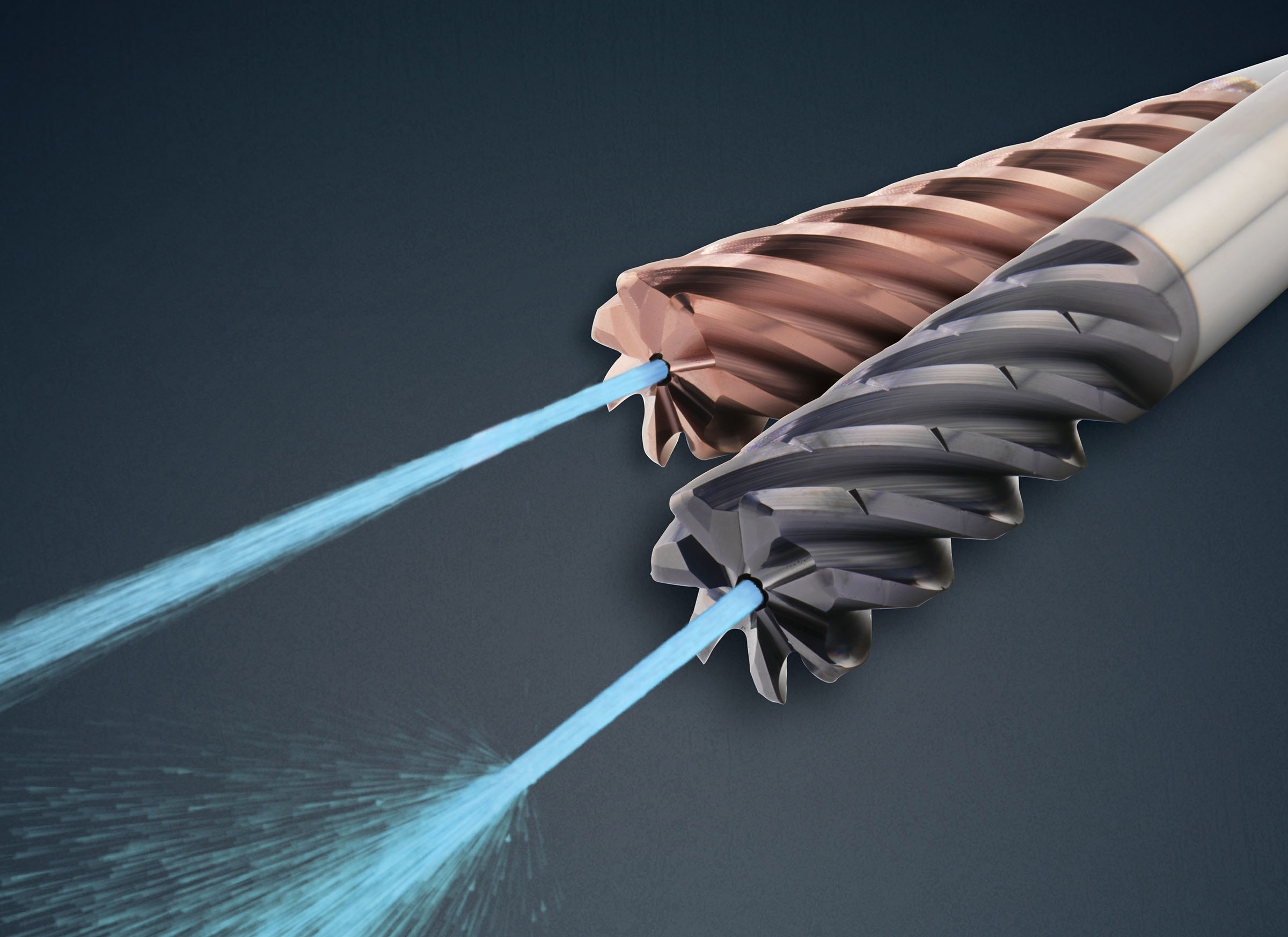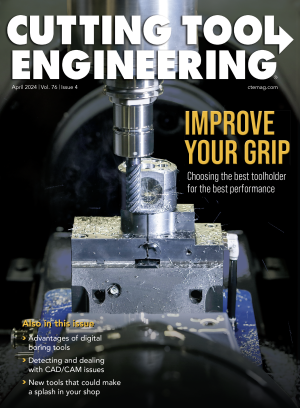When the job calls for going deep, these new tools could make a splash in your shop.
The tools are an extension of the line of H-Carb seven-flute carbide endmills from Kyocera SGS Precision Tools Inc. in Cuyahoga Falls, Ohio. What sets the new offerings apart is a central hole that delivers coolant to the cutting zone in order to reduce wear and improve chip evacuation in deep pocketing and slotting applications.
The 400-plus new coolant-through options also feature a standard chip-breaker profile to facilitate chip flow. But even when using a chip-breaker tool for deep pocketing, “some of those chips can still be a little bit heavy and hard to evacuate from the pocket,” noted Jake Rutherford, a research and development engineer at Kyocera SGS Precision Tools. “The through-coolant really helps get that material out of there so you’re not recutting chips and causing premature damage to your tool.”

According to Rutherford, the main advantage of the coolant-through feature is probably the boost it gives to a tool’s ramping capabilities. “With a helical ramp, there’s a lot of heat down at the bottom where the cutting is actually going on,” he explained. “The deeper you get, the more critical that coolant flow becomes and the more difficult it is to get coolant to that cutting edge.”
By delivering large amounts of coolant to the place where it’s needed, the coolant-through tools allow shops to use up to six times greater ramp angles than those recommended for tools lacking this feature, Rutherford said. “And running at that steeper angle allows you to get to the bottom of your pocket faster, reducing your cycle time.”
Available in three lengths of cut (2.5xD, 3xD and 4xD), H-Carb tools are designed for improved rigidity as well as chip flow. “We vary the design based on the flute length in order to [prevent] the increased deflection you commonly see at longer lengths of cut,” Rutherford noted. “The longer the flute length, the more rigid the tool is through a heavier core.”
The H-Carb’s seven-flute design produces excellent finishes at higher feed and speed rates than five- and six-flute tools, according to Kyocera. In addition, the line includes a wide range of square-end and corner-radii options to meet a variety of machining requirements.
H-Carb tools are suitable for cutting steel, stainless steel and cast iron, as well as titanium and high-temperature alloys. However, the tools should be limited to cutting materials with a hardness that does not exceed 45 HRC. For materials such as hardened steel, “we would point the customer to more of a mold and die-style tool with a geometry that is optimized for that material,” Rutherford said.
For increased wear and abrasion resistance, tools in the expanded H-Carb line come with either Ti-Namite-A or Ti-Namite-M coating technology. The Ti-Namite-A coating is optimized for cutting stainless steels and high-temperature alloys, while Ti-Namite-M is aimed at applications involving steels, cast irons and titanium.
The new endmills are a good fit for deep-axial trochoidal and high-speed machining processes in a variety of industries, including aerospace, medical, power generation, automotive and foundry, according to Kyocera. “We typically don’t make application-specific tools because we don’t want to pigeonhole ourselves,” Rutherford said. “Anywhere you have a deep pocket and you’re able to apply a trochoidal-style tool path, that’s where these tools excel.”
Related Glossary Terms
- alloys
alloys
Substances having metallic properties and being composed of two or more chemical elements of which at least one is a metal.
- cast irons
cast irons
Cast ferrous alloys containing carbon in excess of solubility in austenite that exists in the alloy at the eutectic temperature. Cast irons include gray cast iron, white cast iron, malleable cast iron and ductile, or nodular, cast iron. The word “cast” is often left out.
- coolant
coolant
Fluid that reduces temperature buildup at the tool/workpiece interface during machining. Normally takes the form of a liquid such as soluble or chemical mixtures (semisynthetic, synthetic) but can be pressurized air or other gas. Because of water’s ability to absorb great quantities of heat, it is widely used as a coolant and vehicle for various cutting compounds, with the water-to-compound ratio varying with the machining task. See cutting fluid; semisynthetic cutting fluid; soluble-oil cutting fluid; synthetic cutting fluid.
- feed
feed
Rate of change of position of the tool as a whole, relative to the workpiece while cutting.
- hardness
hardness
Hardness is a measure of the resistance of a material to surface indentation or abrasion. There is no absolute scale for hardness. In order to express hardness quantitatively, each type of test has its own scale, which defines hardness. Indentation hardness obtained through static methods is measured by Brinell, Rockwell, Vickers and Knoop tests. Hardness without indentation is measured by a dynamic method, known as the Scleroscope test.
- slotting
slotting
Machining, normally milling, that creates slots, grooves and similar recesses in workpieces, including T-slots and dovetails.
- stainless steels
stainless steels
Stainless steels possess high strength, heat resistance, excellent workability and erosion resistance. Four general classes have been developed to cover a range of mechanical and physical properties for particular applications. The four classes are: the austenitic types of the chromium-nickel-manganese 200 series and the chromium-nickel 300 series; the martensitic types of the chromium, hardenable 400 series; the chromium, nonhardenable 400-series ferritic types; and the precipitation-hardening type of chromium-nickel alloys with additional elements that are hardenable by solution treating and aging.



 ARTICLES
ARTICLES



